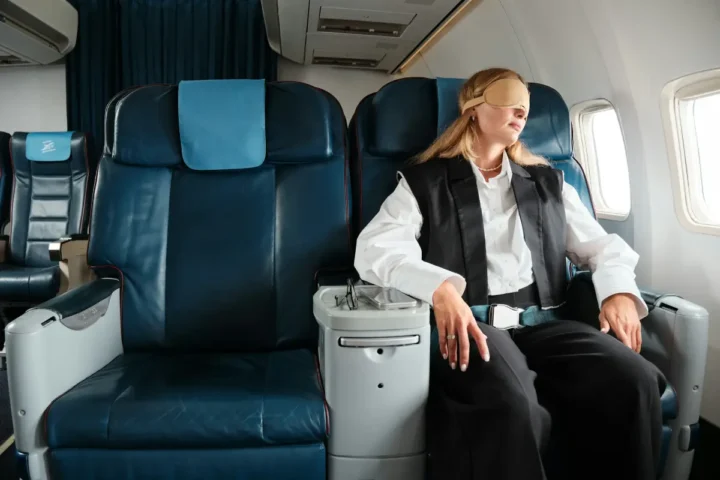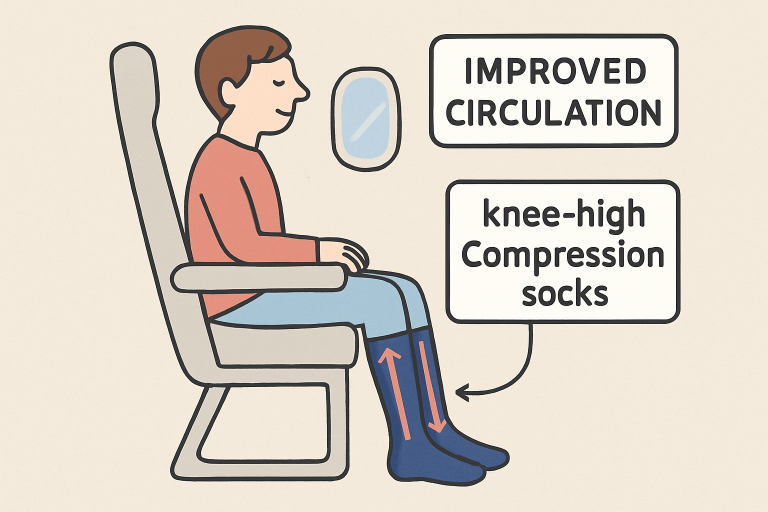Why Compression Socks Are a Must-Have for Long-Haul Flights
Embarking on a long-haul flight is often a blend of anticipation, excitement, and a hint of trepidation. While the prospect of reaching a distant location is enticing, there’s no denying that spending hours in a pressurized cabin can present unique physical challenges.
Being confined to a small seat in a crowded aircraft, unable to move freely for extended periods, can have noticeable effects on your body, from muscle stiffness to swollen ankles. One of the most critical and easily overlooked ways to maintain comfort and well-being is to include a pair of flight compression socks in your travel essentials.
These socks are designed to address the issues caused by prolonged immobility, ultimately helping you arrive at your destination feeling your best. Compression socks are recommended by seasoned travelers, flight attendants, and medical professionals for in-flight comfort and health. They minimize swelling and discomfort during long journeys and may reduce the risk of severe conditions like deep vein thrombosis (DVT), a blood clot disorder exacerbated by prolonged travel.

Understanding the Impact of Long Flights on Your Body
Air travel can compromise the body’s circulation, leading to swelling known as “edema” and heavy or stiff legs. This discomfort can pose serious health risks, especially for those with underlying health concerns. One of the main risks is the development of deep vein thrombosis (DVT), where a blood clot forms in deep veins, usually in the thighs or calves.
Untreated, this can lead to pulmonary embolism. Dehydration, caused by decreased cabin pressure at cruising altitude, thickens blood, increasing clotting risk. Risk factors such as obesity, pregnancy, a history of clotting disorders, or hormonal medications should be especially vigilant during air travel. Dehydration thickens blood, increasing clotting risk.
How Compression Socks Work
Compression socks are medical-grade garments that apply graduated pressure to the lower legs, concentrating the highest pressure around the ankles and gradually decreasing pressure as the material stretches upward towards the calves. This configuration encourages veins to push blood back towards the heart, combating blood pooling in the lower limbs.
Compression socks support the valve system of veins, making blood more efficient and reducing swelling. Medical studies show that individuals using compression garments are less likely to suffer from DVT and other circulation-related complications during long periods of immobility, such as air travel.

Benefits of Wearing Compression Socks During Flights
Compression socks are popular for travelers due to their numerous health benefits. They improve circulation, reduce leg stagnation, and reduce swelling, common after long flights. These socks prevent blood and lymphatic fluid accumulation, ensuring comfortable shoes upon landing and preventing “heavy legs.” They also help prevent deep vein thrombosis, a risk associated with prolonged sitting, by providing an extra layer of safety.
Compression socks also offer increased comfort, reducing fatigue and aching often accompanying long sitting periods. They can help individuals feel energized and ready to explore, rather than cramped and sore. Choosing a high-quality, travel-specific pair, such as flight compression socks, can significantly improve the experience during travel and the recovery process upon arrival.
Choosing the Right Compression Socks for Travel
Compression Level: For most air travelers, socks with moderate compression (typically 15-20 mmHg) strike the right balance between effectiveness and comfort. This level provides enough support to keep blood circulating without being overly restrictive, so that you can wear them for the entire journey without discomfort.
Fit and Size: A correct fit is vital for the effectiveness of compression socks. Too loose and you won’t benefit; too tight and you may feel restricted or even exacerbate circulation problems. Use the manufacturer’s sizing charts and measure your calf and ankle circumference in the morning for the most accurate fit.
Material: Fabric choice makes a significant difference in comfort. Look for socks made from lightweight, breathable materials such as nylon blends, which wick moisture away from your skin. This keeps your feet dry and cool, minimizing irritation and the chance of developing blisters or rashes during long hours in shoes.
Additional Tips for a Comfortable Flight
- Stay Hydrated: Drink plain water frequently throughout your flight. Proper hydration thins your blood and counteracts the dryness of cabin air, contributing to a healthier, more comfortable travel experience.
- Movement is Key: If possible, get up and move around the cabin every two hours. Simple movements, such as ankle circles, toe taps, or calf raises, can keep your blood circulating while seated. For examples of in-seat stretches, consider reviewing Cigna’s in-flight exercise guide.
- Wear Loose, Comfortable Clothing: Choose clothing that doesn’t inhibit blood flow in your legs or waist. Lightweight, breathable fabrics that don’t constrict are best for optimal comfort and circulation.
Combining innovative travel strategies—such as those above—with the protective benefits of compression socks ensures a more comfortable, healthier flight. These small changes can transform your in-flight experience, supporting you to arrive refreshed and ready to explore your destination without lingering aches or swelling.
Prepare for your next flight with the right essentials, smart travel habits, and a reliable pair of flight compression socks. With some planning and the right tools, you’ll be equipped to make every journey—from takeoff to landing- a smoother, safer, and more comfortable.


